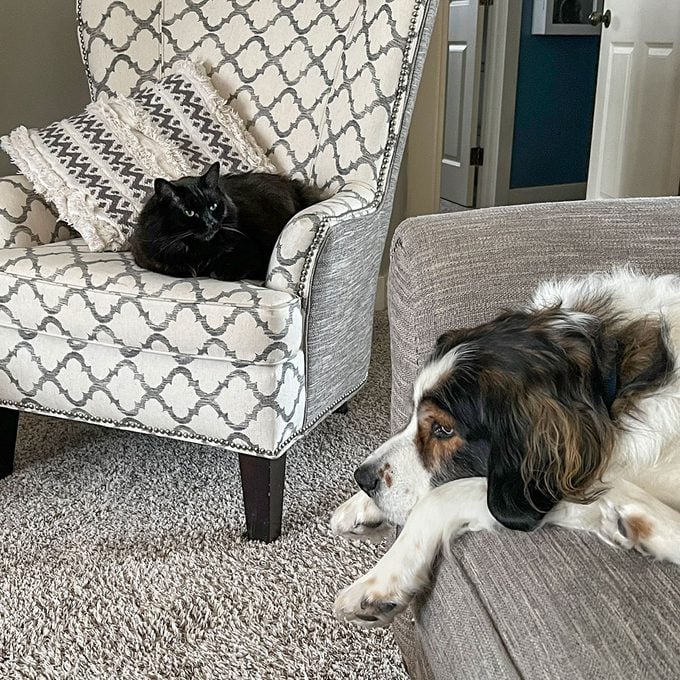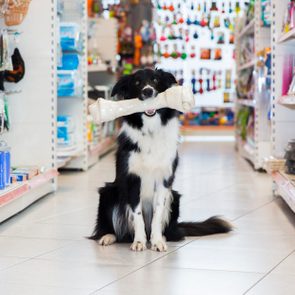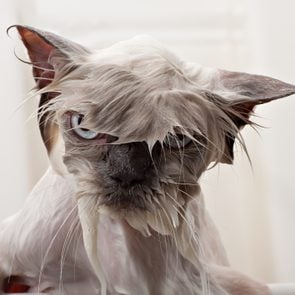Do Cats Get Jealous—and How Can You Stop Their Catty Behavior?
Updated: Mar. 05, 2024

Some cats hiss and swat when new pets, babies or people come around, but is this jealousy in action or just a cattitude? Experts explain.
We’re captivated by our little lions. They’re independent, mysterious and aloof, yet also affectionate and loving. Their unpredictable cat behavior is fascinating and perplexing all at once. For instance, have you ever noticed when a new human or animal enters the picture, they get ferociously catty? I’ve seen this with my grand-kitty, Mabel, a gorgeous black cat that is usually sweet and lovable. But when she visited our house, ruled by my dog Archer, the claws came out. Do cats get jealous? Even though Archer is totally chill and does nothing to provoke her, Mabel either stalks him from up high, swats his face when he walks by or runs off like a jilted lover. It sure sounds like jealousy.
Mabel’s cat body language makes you wonder why cats act out this way when a new human or pet enters their kingdom. Could it be the cat is mad at me for allowing this strange pet into her world? Or is her jealous-like behavior due to stress and cat anxiety? We asked cat behaviorists to unravel this meow mix of emotions—and help us better understand what to do about it.
Get Reader’s Digest’s Read Up newsletter for pets, humor, cleaning, travel, tech and fun facts all week long.
About the experts
|
Do cats get jealous?
Cat behaviorists can’t be sure our little lions turn into green-eyed monsters and feel the jealousy emotion the way humans do, but cats are continually adapting to their surroundings, investigating and interpreting the underlying factors around them as being neutral, positive or aversive. So when cats act out by hissing, hiding or biting as a response to your friend’s dog visiting, it may look like jealousy, but they’re likely just feeling anxious or stressed.
Research found that when it comes to stress, felines have two common triggers: physical and psychological. Interestingly, psychological triggers (a change in routine or a new person in the house) are more potent than physical triggers, such as an illness. Psychological triggers are the most likely to cause jealousy.
“Cats are all about their space and their pecking order,” says Michael Thompson, DVM, lead veterinarian and cat behaviorist at Pets Food Safety. “Imagine they’re like little lion kings and queens ruling their indoor jungle. When a new pet or even a piece of furniture comes in, it’s like an unexpected guest in their kingdom, and they may act out to assert their royal authority.”
What do cats get jealous of?

Two things are certain with cats: They thrive on predictability, and they think they own everything in their kitty kingdom. In the cat’s mind, possession isn’t 9/10 of the law. It’s 10/10 of the law. They can get a royal cattitude and bring out their claws when something or someone threatens that.
“Cats are like little guardians of their own personal treasure chests, which include food, the perfect napping spot and, yeah, even you,” says Dr. Thompson. “They want to make sure they have first dibs and will do what it takes to stake their claim.” Your cat may guard their food or block another human from getting too close to you. But they’re basically saying, “Hey, this is mine!” Here are some things a kitty might become jealous of.
A new pet
There are cat breeds that get along with dogs. And cats can be chummy with other types of furry friends too. So do cats get jealous upon the arrival of a new pet? Likely. “Bringing another pet home is like throwing a curveball at your cat,” says Dr. Thompson. “They see the new guy as competition for food, space and your love.”
A new baby
Cats love baby talk when you speak to them, but how do they feel about an infant sharing your unique love language? When a new baby arrives, it’s the baby that takes center stage. Suddenly, humans are devoting every moment to the care of this new person in the house—who also cries and smells funny. “A new baby will soak up a lot of your attention, and your cat might feel a bit left out. It’s a big change for them too,” Dr. Thompson says.
A new piece of furniture
Do cats get jealous of inanimate things? As crazy as it sounds, it’s a weird cat fact that they can become jealous of a piece of furniture. “It’s kind of amusing when you think about it,” says Dr. Thompson. “You might not think your new coffee table is a big deal, but your cat might see it as an invader in their territory.”
The same does not apply to new cat scratching posts, cat condos and other feline furniture. However, once your cat has accepted their cat furniture, they may become possessive of it and get jealous, especially if you have multiple pets. “At that point, they might display behavior that we’d interpret as jealousy if another pet tries to use their beloved tree or bed,” says Dr. Thompson.
A new friend or partner
It’s not a stretch to see why a new baby could upset the kitty kingdom, but do cats get jealous of a new friend or partner that wants to be friends and treats the cat kindly? Even with the best intentions, a cat may still sense a disturbance in the force. “Cats can be little attention hogs. If you’re spending time with someone else, whether it’s a friend or a romantic partner, don’t be surprised if your cat tries to steal the spotlight,” Dr. Thompson says.
How do cats show jealousy?
Do cats get jealous and act out in obvious ways? Not always. Cats are notorious for sending mixed messages. One minute, they’re lovey-dovey, purring in your lap. Seconds later, they’re doing zoomies and knocking stuff off the coffee table. To figure out if your little lion is acting out in jealousy, you have to look closely at their behavior and check for emotional clues indicating jealousy.
“At the root, jealousy in cats is about their territory being threatened,” says Joey Lusvardi, a cat behaviorist and the owner of Class Act Cats in Minneapolis. “They worry that they may be cut off from an important resource like cat food, a litter box or even a human.” You might see jealousy in action when cats try to monopolize someone or attempt to get rid of rivals for affection, attention and resources. Here are some behavior clues to look for.
Swatting and blocking
Cats may voice their jealousy with an angry meow, while others prefer the silent kitty ninja approach. “Cats may swat at an invader in their space, or they may physically try to block off a resource by laying between another cat or animal and the resource,” says Lusvardi.
Showing more affection
Affectionate behaviors could be a sign of jealousy. “For example, your cat may rub up against you more to get their pheromones all up on you,” says Lusvardi. Or your cat may be uber-affectionate and snuggle up close to you when another animal or human is nearby. In reality, they could be just trying to squeeze out the competition.
Attention-seeking behaviors
“Cats are really, really smart, and they’ll figure out a way to get your attention,” says Lusvardi. They might start to jump onto counters, groom themselves more or become more vocal than usual. They may also act out in weird ways you haven’t witnessed before.
Peeing outside the litter box
Since jealousy stems from territorial issues, cats might mark outside of their litter box to send a clear message: This kingdom is mine. But there are many reasons cats don’t use their litter boxes. A new pet may have blocked access, the box is too close to another pet’s stuff or it could be a sign your cat is sick.
Are some cat breeds more jealous than others?
Do cats get jealous if they are of a particular breed? Not really. Although Siamese cats (known for being one of the friendliest cat breeds and notably super smart) tend to be very particular about their territory. “Siamese cats are some of my favorite cats, but they tend to be very attached to their humans, so they can see any invader into their space as a threat,” says Lusvardi. When it comes to degrees of envy, it’s more about how the cat was raised and if there have been enough resources to meet the cat’s needs. “For example, if a cat was living on the streets and didn’t have food for the first part of their life, they may be jealous when there is any threat to a food supply.”
How can you prevent jealousy in cats?
Don’t be surprised if you witness some stress-induced and resource-guarding behaviors, like hissing, swatting, hunching up their back or blocking. It’s normal for a cat to warn other animals and humans to back off by doing these things. Help prevent those jealous-like behaviors by providing stress-free access to fulfill their basic needs of scratching, climbing, lounging, eating and using the litter box. And since cats are creatures of habit, it’s a good idea to stick to their normal routine. Here are some steps to help cats adjust.
Set up the purr-fect environment
You might be inclined to give your cat their own private domain by putting all their resources (litter box, toys, food) in one location. But cats actually like their stuff spread around multiple locations, which can also help pave the way to more harmonious relationships. “Mixing their resources in with things that belong to other pets or humans is the way to go, as it will help the cats feel like their whole space is theirs,” says Lusvardi. If the source of jealousy is another cat, each cat should have their own set of resources, Lusvardi says.
Provide plenty of playtime
Routines are bound to change when a new human or pet enters the household. You may spend more time with the new person or pet, but it’s essential to maintain playtime and snuggle time with your cat. Predictability eases their anxiety. If you’re introducing a new pet, spend equal amounts of playtime with each cat a couple of times a day.
Teach voluntary sharing
“Voluntary sharing is a pattern game you play with your cat as an exercise to help them realize that others getting something is a good thing,” says Lusvardi. This activity is ideal for cats that have already had some cat training and learned some tricks, such as sitting up or a high five. Usually, the cat gets a treat when they perform a trick. But when you’re playing the voluntary sharing game, they don’t—at least not immediately. Instead, you give the first treat to the other pet or person the cat is jealous of, and then you give the jealous cat their treat. “This teaches the cat that others getting something is a signal that they get something, so sharing is a good thing!”
Praise good behavior
“When they have any interaction with the object of their jealousy that you want, make sure they get praise and attention for doing so,” says Lusvardi. For example, when your cat encounters the source of their jealousy and ignores them instead of acting out, praise them with affection and/or a treat.
How long will it take to make your cat less jealous?
That depends on your cat and the circumstances. Once you set up the proper environment, it may take a week or two to adjust. However, suppose your cat developed a negative association with another cat or pet due to a heated clash. In that case, it may take longer to undo than if there were just a few minor spats. If you’re not seeing any improvements or there is a serious danger of biting and violence to humans or another pet, get in touch with a feline behaviorist right away. Or if you’re frazzled and at your wit’s end, reach out to a pro. “We can help make the process easier and help you get things right quickly,” says Lusvardi.
Want to learn more about the weird quirks and funny habits of your pets? Dr. Phur on The Pet Collective is a seasoned doggy doctor serving up inside information plus the best tips and tricks for the care of all your animal friends.
Why trust us
At Reader’s Digest, we’re committed to producing high-quality content by writers with expertise and experience in their field in consultation with relevant, qualified experts. We rely on reputable primary sources, including government and professional organizations and academic institutions as well as our writers’ personal experience where appropriate. We verify all facts and data, back them with credible sourcing, and revisit them over time to ensure they remain accurate and up to date. Read more about our team, our contributors and our editorial policies.
Sources:
- Michael Thompson, DVM, founder and lead veterinarian and cat behaviorist at Pets Food Safety in Austin, Texas. Dr. Thompson has a lifelong passion for animal health, specializing in pet nutrition. He created Pets Food Safety to help parents navigate the saturated pet food market by providing science-based and comprehensive guides on the safety of various food items for dogs and cats. He lives harmoniously with his cat Nimbus and dog Jax, a Jack Russell terrier.
- Joey Lusvardi, certified cat behavior consultant and the owner of Class Act Cats in Minneapolis. He’s always been an animal lover, but when he faced cat behavior challenges with his adopted cat, Zoloft, he decided to become a cat behaviorist to help cats and their humans lead more harmonious lives. He also works as a psychiatric physician assistant and trains cats to become therapy animals. Sadly, Zoloft, the first chief purr officer, recently passed away. His successor, Prozac, is a former stray Siamese cat enjoying his new forever home and lots of love and treats.
- Frontiers in Veterinary Science: “Dealing with Stress in Cats: What Is New About the Olfactory Strategy?”






















